Panelists Explore Network Centricity's Many Facets
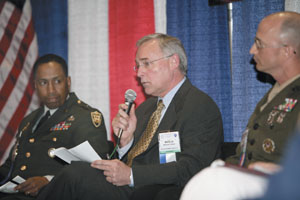 |
| Brig. Gen. Dennis Via, USA (l), principal director for Global Information Grid (GIG) operations, Defense Information Systems Agency (DISA), and Col. Eric Rolaf, USMC (r), commander, U.S. Marine Corps Network Operations and Security Command, listen as Marlin Forbes (c), vice president, defense and international markets, MCI, explains how his company designed a global system for mobile communications in Afghanistan. |
Maj. Gen. Marilyn Quagliotti, USA, vice director, Defense Information Systems Agency (DISA), conducted the event’s first session by posing questions to panelists who presented an enterprise view of network-centric operations.
First, she asked panelists to explain where they were at the time of the military build-up in
Brig. Gen. (Sel.) David Warner, USAF, director for command, control communications and computer (C4) systems, J-6, U.S. Joint Forces Command, explained that he was stationed at U.S. Air Forces in Europe (USAFE) when planning began for current operations. The USAFE Air and
Gen. Quagliotti also asked the panelists about the most significant lessons learned from current operations. Col. Alfred A. Coppola,
Rear Adm. Robert Reilly Jr., USN, deputy for C4 integration and policy, and deputy chief information officer, Department of the Navy, agreed with Col. Coppola and added that forces learned the consequences of outrunning their communications capabilities. The importance of blue force tracking and situational awareness increases as air tasking orders are created on the fly and as the number of warfighters who can gather and share information on the ground decreases, he said.
Tuesday’s second panel focused on global security in a network-centric environment. The panelists, led by Gen. Ralph Eberhart, USAF (Ret.), president of the Armed Forces Benefit Association and former commander of the U.S. Northern Command (NORTHCOM) and the North American Aerospace Defense Command (NORAD), agreed that expanded connectivity through the introduction of new technologies will challenge the military in the areas of knowledge management, information security, training and operations.
Maj. Gen. Charles Croom Jr., USAF, designated to be DISA’s next director, talked about connecting networks worldwide via an Internet-protocol-enabled network in the sky that will be in place in approximately two years. Although this connectivity will allow global collaboration, the military will have to determine whether this new capability is an enabler or another vulnerability. “The need is great, but the threats are great,” Gen. Croom noted.
Access to so much information can pose the additional problem of information overload, offered Maj. Gen. David Bryan, USA (Ret.), vice president, Defense Department Transformation, Northrop Grumman Information Technology. Gen. Bryan proposed a rather unique approach to handling this problem that could help the military shift from network to knowledge centricity. He suggested that a biological rather than mechanical model be considered when developing techniques for managing information. Researchers should examine how the brain handles seemingly unrelated facts to discover connections. Taking this approach will lead to knowledge centricity, which in turn will lead to operational speed and agility, he said.
Panelist David Landeta, chief technologist, secure communications group, Harris Corporation, offered his insights on the role of wireless technologies in the network-centric environment. He pointed out that current wireless security standards were not intended to address the security of critical information. Network managers who deploy wireless devices must understand the vulnerabilities; however, Landeta believes that with the right security measures, wireless equipment could even be deployed on the battlefield.
Although “network-centric operations” is a term that is most often associated with the military, it is a concept that industry has used to achieve its goals as well. Many of the lessons companies have learned while linking their computer systems are applicable in the military environment. A panel led by Kent Schneider, president, defense enterprise solutions, Northrop Grumman Information Technology, addressed this topic. Industry representatives participating in Wednesday’s first panel emphasized that serving customers must be the primary focus when deploying technologies.
Businesses face some of the same problems as does the military when establishing network-centric operations, the panelists concurred. For example, Dr. Peter Bahrs, chief technology officer, government solutions, IBM Corporation, said his company found that its systems were segregated along business lines. Rather than trying to create an enterprisewide connection, the company chose to create middleware that loosely combines the systems and creates a service-oriented architecture (SOA).
Adding an international perspective to the discussion, Dr. Uwe Leinberger, Europe Toll Collect, T-Systems, explained how his company created a toll collecting system for the Autobahn. The government wanted a way to charge trucking companies for using the road without impeding traffic flow by stopping truckers at toll booths. The networking project involved creating the system, installing data collection boxes, and designing technology maintenance and upgrade plans. Leinberger said the system began operation in January, and his company already is searching for new ways to use it.
Network-centric operations and homeland security was the topic of discussion for a panel led by Maj. Gen. Dale W. Meyerrose, USAF, NORAD’s director of command control systems and NORTHCOM’s director of architectures and integration. The general opened the session by pointing out that warfighting coalitions comprise joint and multinational military forces, but homeland defense and homeland security operations demand that the services and government agencies all work with each other.
Rob LeGrande, deputy chief technology officer for homeland security,
Network centricity is inevitable, said Arthur L. Fritzson, vice president, Booz Allen Hamilton; however, the diversity of the groups involved in homeland security and homeland defense aggravates the challenge. He suggested that agencies examine the file-sharing approaches music lovers use, which includes setting up file specifications so users can “speak” to the network as a whole rather than relying on a one-on-one communications method. He admitted that security, data quality and messaging protocols prevent agencies from using file sharing today, and industry must address those obstacles, he said.
Debra Filippi, senior program manager executive, Net-Centric Enterprise Services (NCES), DISA, predicted a cultural revolution in information sharing and warned, “Box huggers beware. Things are changing.” Endorsing an SOA, Filippi favors an approach that would allow users to query databases to determine whether information already is available before creating a new database. In terms of information assurance, Filippi said organizations must determine what they are willing to sacrifice in the interest of security.
Thursday’s first panel focused on network-enabled operations from the combatant’s perspective. The panelists, all of whom had combat experience in
Ground operations also greatly benefited from networked applications. Col. Dan Allyn,
Although inter-service cooperation is now standard, issues still remain. “Jointness is almost passé. We’re there,” said Panel Moderator Lt. Gen. James Conway, USMC, director of operations, J-3, the Joint Staff. But he added that the services’ communications equipment is still not fully interoperable. The panelists noted that text-based messaging was faster than voice communications, which could become garbled, leading to lengthy repetitions of coordinates and information. Other problems included difficulty in sharing files across networks and in addressing line-of-sight requirements for terrestrial communications.
Difficulty in locating and identifying enemy forces was a major issue for coalition ground forces during operation Iraqi Freedom, Col. Allyn observed. Although
The J-6 panel explored the larger issues of maintaining and coordinating a global information architecture. Lt. Gen. Robert M. Shea, USMC, director of C4 systems, J-6, the Joint Staff, noted that networks are ubiquitous throughout the U.S. Defense Department. As these systems continue to grow, protecting them remains a challenge, he said. Gen. Shea outlined various steps the military is taking to enhance network defense, such as conducting threat assessments, creating a joint campaign plan for information assurance, working with industry to develop security policies and developing common tools to assess and repair network vulnerabilities.
Robert Thomas, U.S. Air Force deputy chief information officer, outlined the agency’s recent networking initiatives. These include efforts to enhance machine-to-machine communications and to improve coalition information sharing. He added that challenges remain in securing coalition networks.
Networking issues also pose problems for the Navy. Rear Adm. Elizabeth Hight, USN, assistant director for C4, Naval Operations, noted that a number of issues will arise when the service develops truly ad hoc networking capabilities. Decisions the Navy must make include determining which command has authority over the network. She added that other considerations involve choosing centralized versus decentralized acquisitions and selecting the right technical solutions for different domains.
The convergence of wireless and Internet protocol technologies and the implications for the Defense Department were outlined by Lt. Gen. Steven Boutelle,
In addition to TechNet panel discussions, the event provided a forum for presentations from DISA representatives.
While many TechNet exhibitors touted the “interoperability” of their products, a key defense figure forecasted the term’s demise. “There will be no interoperability,” Filippi told TechNet attendees during a DISA-sponsored presentation. “We’re eliminating the notion of interoperability because if you don’t meet the criteria, you cannot plug [into the network],” she stated. Filippi interrupted her discussion to instruct an assistant to strike the word “interoperability” from future presentations.
“We’re moving from a need-to-know to a need-to-hide environment,” Filippi said. Everyone will be joint by definition because every authorized user will have one capability, she said.
Network centricity not only eliminates system incompatibilities, but it also reduces hassles related to system upgrades, Filippi stated. She invited her audience to imagine a time when incompatible software versions no longer plagued users. “We won’t have five different versions, but one,” she said.
The critical enabler for such accessibility is the GIG, David Mihelcic, DISA’s chief technology officer, said during his presentation as part of Tuesday morning’s DISA Forecast to Industry. Building the GIG will require migrating “tens of thousands of legacy systems over to the network service-oriented architecture,” Mihelcic added. The move away from systems and to network centricity via the GIG will enable “anyone to talk to anyone else,” he stated.
To get there, NCES—the DISA program charged with providing the GIG’s underlying applications—is rolling out a measured implementation schedule. “We’re not looking for a ‘big bang.’ It’s an evolutionary move,” Filippi said.
The program’s first step toward enabling the GIG involves building the foundation for enterprise collaboration, content discovery, an enterprise SOA and defense online portal components. Filippi expects that foundation to be in place by the spring of 2007. The agency will launch a next-generation collaboration service pilot involving a small, defined community to test implementation, she said. “If it’s good for them, it’ll be good for everyone,” she added.
Acquiring existing commercial technology is pivotal to quick implementation, Filippi said. The solution for making data recognizable to different systems already is available, she added, citing America Online, e-Bay and Amazon.com as examples. The approach is to acquire available commercial technology rather than develop it from scratch.
“Agile acquisition accommodates net centricity,” said Diann McCoy, DISA’s component acquisition executive, during her presentation at the agency’s Forecast to Industry. This “see-try-buy” approach contrasts with DISA’s past “conceive-develop-demonstrate” process and streamlines acquisition from years to months to even weeks, McCoy stated. DISA’s big new question, she said, becomes what does the military need as opposed to how does the military develop technology to meet its needs.
Still, the approach offers new and inherent dangers, McCoy warned. “We do not want to reduce security, safety or reliability,” she said. The new acquisition model involves pilot testing, certification and finally release. “We make sure the foundation is correct and then bring things rapidly into the architecture,” McCoy added. The result will be loosely coupled, but secure, Web services versus tightly integrated systems, she said.
Security for such an accessible network is critical. “We’ll be buying crypto,” Richard Hale, DISA’s chief information assurance executive and technical director, told TechNet attendees during his presentation. Hale cited the acquisition of anomaly detection technology as a top priority. The technology identifies “anything that doesn’t look normal,” Hale said. It reaches beyond most intrusion detection schemes that typically compare incoming traffic against documented attackers and stored data. For critical hosts, the agency is aiming at host-based attack detection, said Hale. The technology can examine activity on each computer rather than on each network.
The agency also needs tools to help collect, analyze, fuse and thin out “tons and tons of data,” he added, noting that sometimes agency personnel are “going through this data by hand.” Data fusion help is on the way, Hale stated. “We’ll do something this year. We think we can write a pretty good spec for [data fusion technology],” he said. Other priority acquisitions include firewall technology, information assurance modeling and simulation tools, and “other insider threat detection tools,” he said.
To ensure bandwidth exists for GIG users, DISA initiated a program to expand capability before assets such as unmanned aerial vehicle video feeds put a burden on the system, said Anthony Montemarano, director, GIG–Bandwidth Expansion program. Montemarano, who spoke at one of DISA’s presentations on Wednesday, keyed on the emergence of Internet protocol technology for transmitting voice, video and data information.
Photography by Mike Carpenter
 | During a panel session discussion titled Global Security in a Network-Centric Environment, Maj. Gen. David Bryan, USA (Ret.) (at podium), vice president, U.S. Department of Defense Transformation, Northrop Grumman Information Technology, explains that knowledge centricity should be the goal for the military. Members of the panel include (seated, l-r) Brig. Gen. (Sel.) David Warner, USAF, director for command, control, communications and computer (C4) systems, J-6, U.S. Joint Forces Command; Capt. Deborah McGhee, USN, team leader for information assurance, Chief Information Office, Department of the Navy; Gen. Ralph Eberhart, USAF (Ret.), president of the Armed Forces Benefit Association and former commander of U.S. Northern Command (NORTHCOM) and the North American Aerospace Defense Command (NORAD); then-Maj. Gen. Charles Croom Jr., USAF, DISA’s director designate; and David Landeta, chief technologist, secure communications group, Harris Corporation. |
 | Representatives from industry discuss network centricity in the commercial sector. Panel participants include (l-r) Dr. Peter Bahrs, chief technology officer, government solutions, IBM Corporation; Jimmy G. Burk, vice president, technology services, FedEx; Stephen C. Herndon, senior vice president, global government banking division, Bank of America; Kent Schneider, president, defense enterprise solutions, Northrop Grumman Information Technology; Dr. Uwe Leinberger, Europe Toll Collect, T-Systems; and Tom Knutilla, senior director, Ryder Corporation. |
 | Discussing network-enabled operations from the combatants’ perspective are panelists (l-r) Col. Darryl Roberson, USAF, assistant deputy director for anti-terrorism and homeland defense, J-3, the Joint Staff; Brig. Gen. Randolph Allen, USMC, deputy director for operations, J-3, the Joint Staff; Lt. Gen. James Conway, USMC, director of operations, J-3, the Joint Staff; Col. Dan Allyn, USA, assistant deputy director for regional operations, J-3, the Joint Staff; and Col. John Toolan, USMC, director, Marine Corps University and Staff College. |
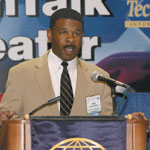 | Rob LeGrande, deputy chief technology officer for homeland security, District of Columbia, explains the intricacies of designing the nation’s first citywide broadband network during a panel session. |
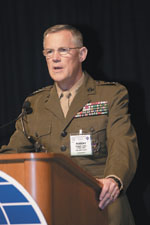 | Lt. Gen. Robert M. Shea, USMC, director of C4 systems, J-6, the Joint Staff, outlines how the military is enhancing network protection during the J-6 panel session. |
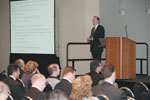 | Richard Hale, chief information assurance executive, DISA, speaks about the agency’s information security plans during an agency-sponsored presentation. |
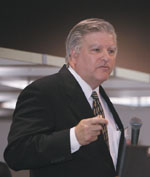 | Anthony Montemarano, program director, GIG–Bandwidth Expansion (GIG-BE), DISA, describes the future of the GIG-BE and the Defense Information System Network. |



